September 2018
the quitting voice: anatomy of a DNF
24/09/18 13:03
I have a self image of myself as strong. When I read about people with true grit, people who finish 100 or 200 mile races or climb Everest, I always envisage myself as one of them. But this race taught me that I am not - not yet.
Whistler Alpine Meadows 110 km race was my dream all year. In the last six months - not a day went by that I did not think about it. I ran almost every step of the planned course this summer, each time visualizing myself at that point in the race. Feeling how i would feel, planning my race strategy. Running Reckless Raven 50+ miler introduced me to the quitting voice but, at the time, I never thought about quitting the race, only quitting running ultras forever - after the race.
What I did not work on enough this summer were the tools to quell the quitting voice. So how did it all unfold?
The training went almost perfectly. i built my mileage to 75 km per week and held it there for weeks, even putting in one 100 km week. I climbed and climbed. At one point, I was 505th in the world [on Strava] for most elevation gain in a single month. The alpine runs were food for my soul and I complied some photos for my Mom of my summer in the alpine. It all felt beautiful, the way life is for fleeting moments.
Okay sometimes, I was a runhole but Lynne had the patience of Job and supported my 830 pm bedtimes by embarking on a new Netflix series.
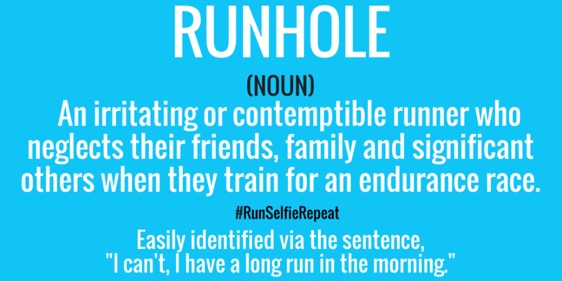
What happened next was a little bit of everything.
1) Course Changes and WEATHER
The first course change sailed into my inbox about 2 weeks before the race. It was minor and worked to my advantage as the second major descent had been changed to a descent that I had run twice this season. All good. Two days later, there was an email warning racers that a course change was coming due to grizzly bear activity on the course. Turned out to be minor for the 100 km runners. But then the big one:
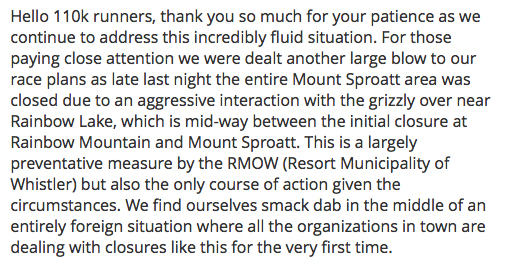
Followed by:
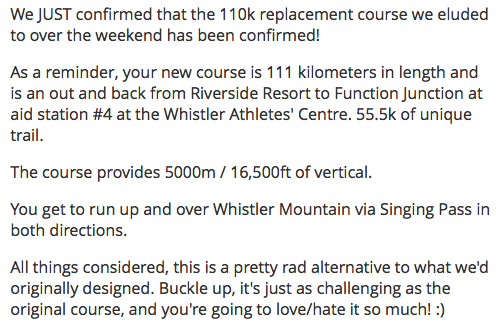
Then followed by:
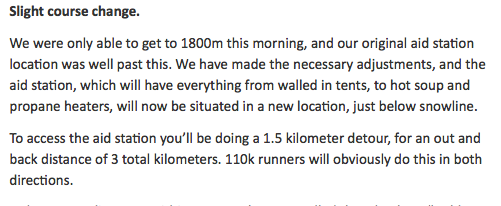
The last change was minor in the bigger scheme of things but it was triggered by what Environment Canada called a complex storm that would eventually dump snow on the local mountains and entail high winds. They couldn't locate the aid station at 2000 m because of snow cover !
All of these course changes were effected by our fearless race directors Geoff and Gary as a response to events totally out of their control. I was in awe of how they managed to keep this race together despite the immense and continuing challenges. But the changes had a knock on effect on my composure. I started waking up every night for several hours worrying with my heart beating hard in my chest. I don't know why they made me so anxious. After all, I knew most of the new course by heart. My sister, Hedda, had the insight that I am a fanatic organizer and planner. But the changes took away my plans and then my contingency plans. It was, as my sister said, not the race I signed up for.
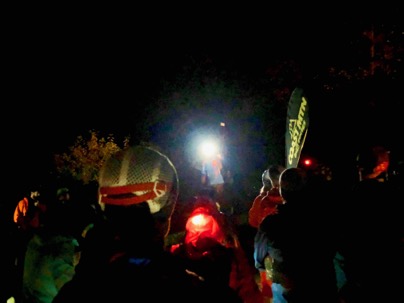
Pre-race briefing at 3:45 am
2) The Descent Into The Third Aid Station
When we reached the top of Harmony in driving snow, running through 5 cm of icy slush, we had to descend several hundred meters (1.5 km) along a steep access road (Pika's Traverse for Whistlerites) to the aid station (in view of the Roundhouse). That descent was easy and I was chipper but climbing back up through the rivers of slush was crushing. Knowing that I would have to come back down there in the pitch dark with a headlamp on was soul destroying.
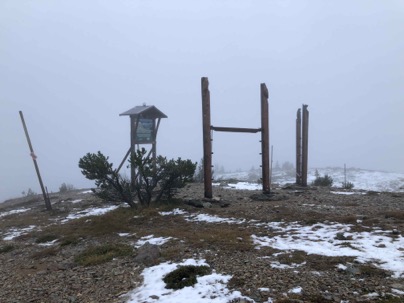
Summit of Flute. Oddly very little snow there, all concentrated at Harmony.
3) Scary Passages and Mud Slides
After leaving the aid station near the top of Whistler, I wended my way along a trail that clung to the side of large granite boulders. At one point, there was a ladder shaped piece of metal chained to a rock slab that I had to inch along with snow blinding me. Fortunately there was a rope to cling to. Though I struggled with my poles, I made it. But that 1.5 meter section of "trail" haunted me later. In my mind, it was now at the top of Everest in -50˙ cold with driving snow - which it was not!
Not long after, I went off course down a double wide track. I only went about 300 m out of my way before I realized that there were no longer any pink flags on my route. No damage done but the worst was yet to come. It is hard to describe the depth and extent of the mud as we ran down the black ♦︎ bike trails (most difficult). Lynne told me later that everyone had fallen and many were more muddy than me. One person had pancaked down face first. Sort of predictable given a week of record rainfall and 300-400 runners over the path earlier in the day - due to the re-routed 55 km course.
4) Flawed Nutrition
Looking back at Reckless Raven, it is clear that I stopped eating about halfway and the rest is predictable. Gary told me before this race that my finishing "depends on calorie consumption." My plan was to average over 200 calories per hour. I practiced with a combo of Torq gels, Maurten and white rice and it worked perfectly. On race day, it was going swimmingly until I met Lynne at the halfway point. There I realized that, in my anxious pre-race state, I had packed my extra bags of rice in the drop bag at the 88 km point - not the turn around point. Lynne was a hero and found me fried potatoes and butternut squash soup. She literally took care of everything possible at that aid station. But I had goofed it up.
5) Calf Strain
As I neared the turn around point, I started to notice that the top of my right calf near the attachment to the knee was very sore - only when climbing up. It hurt more and more each time I went up. Downhill running was totally fine. I thought to myself that this could be a reason to DNF but was resolved to carry on. At the turn around at Function Junction - where I met Lynne - I rubbed analgesic cream on it. That helped a lot as I started back out on the course with plenty of time to make the cut off of 1030 pm near the top of Whistler (it was 4:10 pm when I left Function).
6) The Swedish Road Stretcher
When I was a teenage in Norway, my Dad used to tell us stories about the Swedish Road Stretcher at the end of long road trips. It took so long to reach our destination because the Swedish Road Stretcher was ahead tugging on the road to make it longer. That is why it seemed like we would never get there. In the last course change email, Gary had said that the course would now be 108 km. But as we headed toward what should have been the 54 km turn around, I (and other runners around me) realized that the course was actually now about 114 km. That would later egg on the quitting voice.
There was something else that I am embarrassed to admit: going into the race, I believed that I could finish in 24 hours. But, by now, I knew it would take me almost right to the 28 hour cut off. That was not in my plan. My ego got in the way. More ammunition for the quitting voice.
7) The quitting voice
After I left the turn around, I was hiking really well. I turned on my phone to listen to music and was rocking it back up the hill. I got about 5 km back up and made myself sip my sickly sweet drink when the quitting voice started. It was sudden and intense. During the cacophony of the voice, I longed for my white rice, hating the sweet drink. Of course the drink was great for me; it just needed a bit of solid food to make it go down (of which I had none). The voice was relentless. I turned off the music to hear it better. Call Lynne it said. If you don't ring her now, she will go to a movie in Whistler and then you will need to hike all the way to the Peak through the mud, into the snow, along the ladder, up the second step of Everest by yourself with a headlamp and not enough food. I remembered the faces of the uphill returning runners I had met. They were hardened and full of resolve - which I did not feel. Even my pal Vicki had whispered "it is really hard, eh."
So, I called Lynne and said "I am quitting; I am coming back down." But Lynne said no. Keep going and don't call me back until 6 pm. It was 5:09. Two runners came up behind me. They were hiking with purpose. You are going on? I asked. Yes, of course they responded. With a heavy heart, I realized that I could easily keep up with their langourous pace and it would save my race to stay with them. I hiked behind them for about 500 m. But the quitting voice hammered away. Quick, turn around and you can be eating dinner in the village with Lynne in an hour or two. I called back. Give it longer, she said. So I laid down on the trail chilling, determined not to eat (so that I would definitely not be able to go on up). Two other runners approached. I asked them with wonder if they were continuing. Oh yes, they responded, we have plenty of time before the 10:30 pm cut off at the Peak. I roused myself and scrambled after them for about 300 m. But the voice screamed at me to go back. In the end, I did.
All four of the final runners that passed me on the See Colours and Puke trail finished under the cut off.
Was the race terrible? No, it was an amazing and wonderful day until 13 hours in. I felt strong and determined throughout the first half. Despite the near constant rain and an early headlamp failure, I saw beauty everywhere.
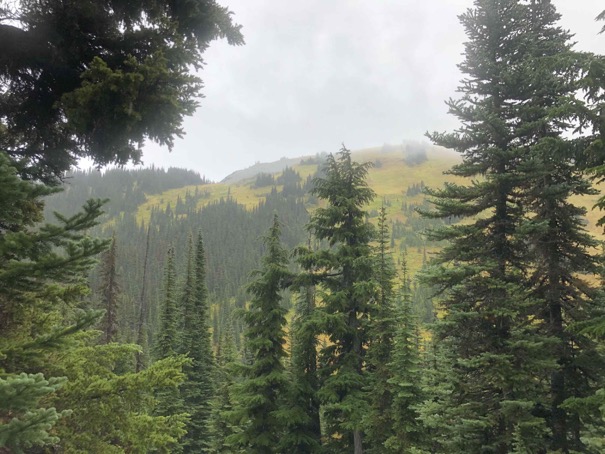
Approaching the top of Singing Pass
On the approach to Oboe and Flute, the views were few but heart searingly beautiful.
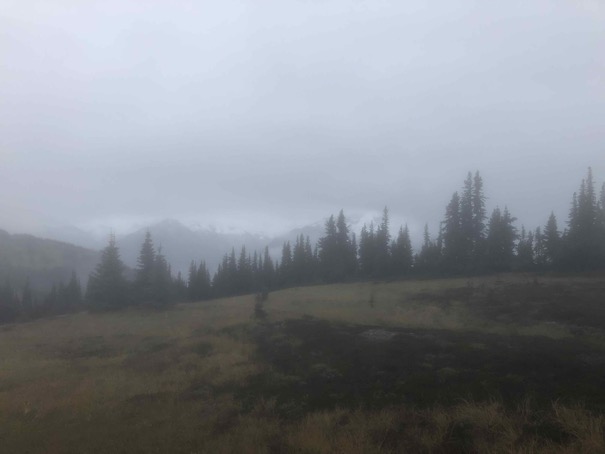
Somewhere on Oboe.
I loved running through the lower forest in the pitch dark and fog. For the first time in my life, I saw luminescent mushrooms glowing from trees, lighting up the path. I saw Laurence who used to live on my street running his first 50+ km and I got a big hug from Terry (who is my age and very very fast) running the opposite way in the 55 km race. There were so many highs and only one big low as I crashed out.
Funny but true. Once I turned around to run back to Function, I felt very sprightly and ran all the way back down the mountain. Only stopping to chat to the sweepers (and declare my DNF). I paused again to talk to the course marshall at the entrance to High Side, who told me that I looked the freshest of anyone she had seen in hours.
Should I have quit? No absolutely not. Do I regret it? Yes. But, as Lynne said, a DNF eventually was inevitable.
Later I found out that a fellow runner, Ben, reached the 88 km aid station throwing up and shaking violently. I quit, he declared. But his crew didn't let him. Instead, they packed him into a sleeping bag where he slept for two hours. Then he got up and finished the race. That is grit.
When I talked to my Mom on the phone trying to explain it, I told her that I couldn't find my WHY. Well, you have until next year to find it, she told me. Best advice.
Whistler Alpine Meadows 110 km race was my dream all year. In the last six months - not a day went by that I did not think about it. I ran almost every step of the planned course this summer, each time visualizing myself at that point in the race. Feeling how i would feel, planning my race strategy. Running Reckless Raven 50+ miler introduced me to the quitting voice but, at the time, I never thought about quitting the race, only quitting running ultras forever - after the race.
What I did not work on enough this summer were the tools to quell the quitting voice. So how did it all unfold?
The training went almost perfectly. i built my mileage to 75 km per week and held it there for weeks, even putting in one 100 km week. I climbed and climbed. At one point, I was 505th in the world [on Strava] for most elevation gain in a single month. The alpine runs were food for my soul and I complied some photos for my Mom of my summer in the alpine. It all felt beautiful, the way life is for fleeting moments.
Okay sometimes, I was a runhole but Lynne had the patience of Job and supported my 830 pm bedtimes by embarking on a new Netflix series.

What happened next was a little bit of everything.
1) Course Changes and WEATHER
The first course change sailed into my inbox about 2 weeks before the race. It was minor and worked to my advantage as the second major descent had been changed to a descent that I had run twice this season. All good. Two days later, there was an email warning racers that a course change was coming due to grizzly bear activity on the course. Turned out to be minor for the 100 km runners. But then the big one:

Followed by:

Then followed by:

The last change was minor in the bigger scheme of things but it was triggered by what Environment Canada called a complex storm that would eventually dump snow on the local mountains and entail high winds. They couldn't locate the aid station at 2000 m because of snow cover !
All of these course changes were effected by our fearless race directors Geoff and Gary as a response to events totally out of their control. I was in awe of how they managed to keep this race together despite the immense and continuing challenges. But the changes had a knock on effect on my composure. I started waking up every night for several hours worrying with my heart beating hard in my chest. I don't know why they made me so anxious. After all, I knew most of the new course by heart. My sister, Hedda, had the insight that I am a fanatic organizer and planner. But the changes took away my plans and then my contingency plans. It was, as my sister said, not the race I signed up for.

Pre-race briefing at 3:45 am
2) The Descent Into The Third Aid Station
When we reached the top of Harmony in driving snow, running through 5 cm of icy slush, we had to descend several hundred meters (1.5 km) along a steep access road (Pika's Traverse for Whistlerites) to the aid station (in view of the Roundhouse). That descent was easy and I was chipper but climbing back up through the rivers of slush was crushing. Knowing that I would have to come back down there in the pitch dark with a headlamp on was soul destroying.

Summit of Flute. Oddly very little snow there, all concentrated at Harmony.
3) Scary Passages and Mud Slides
After leaving the aid station near the top of Whistler, I wended my way along a trail that clung to the side of large granite boulders. At one point, there was a ladder shaped piece of metal chained to a rock slab that I had to inch along with snow blinding me. Fortunately there was a rope to cling to. Though I struggled with my poles, I made it. But that 1.5 meter section of "trail" haunted me later. In my mind, it was now at the top of Everest in -50˙ cold with driving snow - which it was not!
Not long after, I went off course down a double wide track. I only went about 300 m out of my way before I realized that there were no longer any pink flags on my route. No damage done but the worst was yet to come. It is hard to describe the depth and extent of the mud as we ran down the black ♦︎ bike trails (most difficult). Lynne told me later that everyone had fallen and many were more muddy than me. One person had pancaked down face first. Sort of predictable given a week of record rainfall and 300-400 runners over the path earlier in the day - due to the re-routed 55 km course.
4) Flawed Nutrition
Looking back at Reckless Raven, it is clear that I stopped eating about halfway and the rest is predictable. Gary told me before this race that my finishing "depends on calorie consumption." My plan was to average over 200 calories per hour. I practiced with a combo of Torq gels, Maurten and white rice and it worked perfectly. On race day, it was going swimmingly until I met Lynne at the halfway point. There I realized that, in my anxious pre-race state, I had packed my extra bags of rice in the drop bag at the 88 km point - not the turn around point. Lynne was a hero and found me fried potatoes and butternut squash soup. She literally took care of everything possible at that aid station. But I had goofed it up.
5) Calf Strain
As I neared the turn around point, I started to notice that the top of my right calf near the attachment to the knee was very sore - only when climbing up. It hurt more and more each time I went up. Downhill running was totally fine. I thought to myself that this could be a reason to DNF but was resolved to carry on. At the turn around at Function Junction - where I met Lynne - I rubbed analgesic cream on it. That helped a lot as I started back out on the course with plenty of time to make the cut off of 1030 pm near the top of Whistler (it was 4:10 pm when I left Function).
6) The Swedish Road Stretcher
When I was a teenage in Norway, my Dad used to tell us stories about the Swedish Road Stretcher at the end of long road trips. It took so long to reach our destination because the Swedish Road Stretcher was ahead tugging on the road to make it longer. That is why it seemed like we would never get there. In the last course change email, Gary had said that the course would now be 108 km. But as we headed toward what should have been the 54 km turn around, I (and other runners around me) realized that the course was actually now about 114 km. That would later egg on the quitting voice.
There was something else that I am embarrassed to admit: going into the race, I believed that I could finish in 24 hours. But, by now, I knew it would take me almost right to the 28 hour cut off. That was not in my plan. My ego got in the way. More ammunition for the quitting voice.
7) The quitting voice
After I left the turn around, I was hiking really well. I turned on my phone to listen to music and was rocking it back up the hill. I got about 5 km back up and made myself sip my sickly sweet drink when the quitting voice started. It was sudden and intense. During the cacophony of the voice, I longed for my white rice, hating the sweet drink. Of course the drink was great for me; it just needed a bit of solid food to make it go down (of which I had none). The voice was relentless. I turned off the music to hear it better. Call Lynne it said. If you don't ring her now, she will go to a movie in Whistler and then you will need to hike all the way to the Peak through the mud, into the snow, along the ladder, up the second step of Everest by yourself with a headlamp and not enough food. I remembered the faces of the uphill returning runners I had met. They were hardened and full of resolve - which I did not feel. Even my pal Vicki had whispered "it is really hard, eh."
So, I called Lynne and said "I am quitting; I am coming back down." But Lynne said no. Keep going and don't call me back until 6 pm. It was 5:09. Two runners came up behind me. They were hiking with purpose. You are going on? I asked. Yes, of course they responded. With a heavy heart, I realized that I could easily keep up with their langourous pace and it would save my race to stay with them. I hiked behind them for about 500 m. But the quitting voice hammered away. Quick, turn around and you can be eating dinner in the village with Lynne in an hour or two. I called back. Give it longer, she said. So I laid down on the trail chilling, determined not to eat (so that I would definitely not be able to go on up). Two other runners approached. I asked them with wonder if they were continuing. Oh yes, they responded, we have plenty of time before the 10:30 pm cut off at the Peak. I roused myself and scrambled after them for about 300 m. But the voice screamed at me to go back. In the end, I did.
All four of the final runners that passed me on the See Colours and Puke trail finished under the cut off.
Was the race terrible? No, it was an amazing and wonderful day until 13 hours in. I felt strong and determined throughout the first half. Despite the near constant rain and an early headlamp failure, I saw beauty everywhere.

Approaching the top of Singing Pass
On the approach to Oboe and Flute, the views were few but heart searingly beautiful.

Somewhere on Oboe.
I loved running through the lower forest in the pitch dark and fog. For the first time in my life, I saw luminescent mushrooms glowing from trees, lighting up the path. I saw Laurence who used to live on my street running his first 50+ km and I got a big hug from Terry (who is my age and very very fast) running the opposite way in the 55 km race. There were so many highs and only one big low as I crashed out.
Funny but true. Once I turned around to run back to Function, I felt very sprightly and ran all the way back down the mountain. Only stopping to chat to the sweepers (and declare my DNF). I paused again to talk to the course marshall at the entrance to High Side, who told me that I looked the freshest of anyone she had seen in hours.
Should I have quit? No absolutely not. Do I regret it? Yes. But, as Lynne said, a DNF eventually was inevitable.
Later I found out that a fellow runner, Ben, reached the 88 km aid station throwing up and shaking violently. I quit, he declared. But his crew didn't let him. Instead, they packed him into a sleeping bag where he slept for two hours. Then he got up and finished the race. That is grit.
When I talked to my Mom on the phone trying to explain it, I told her that I couldn't find my WHY. Well, you have until next year to find it, she told me. Best advice.
